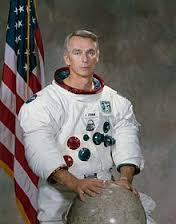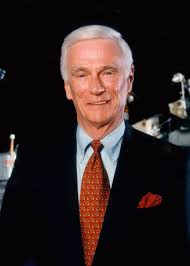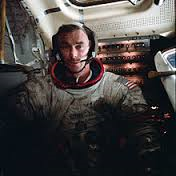Cernan, who entered the International Air and Space Hall of Fame in 2007, was the last of only 12 people to ever leave footprints on the Moon.
Cernan authored the book "THE LAST MAN ON THE MOON."

San Diego, CA – Gene Cernan, one of just 12 Americans, and the last person to ever stand on the Moon, passed away today. He was 82.
During 20 years as a Naval Aviator, including 13 years with the National Aeronautics and Space Administration (NASA), Captain Cernan left his mark with three historic missions in space as the Pilot of Gemini 9, the Lunar Module Pilot of Apollo 10, and the Commander of Apollo 17. As well as flying to the Moon not once, but twice, he also held the distinction of being the second American to walk in space and the last person to have left his footprints on the lunar surface.
“Gene Cernan was a true American hero who served his country with great distinction as a highly decorated Naval Aviator and astronaut, including one of only a dozen people to walk on the Moon,” said Jim Kidrick, President and CEO of the San Diego Air & Space Museum. “As a member of the International Air & Space Hall of Fame, a Naval Aviator who trained right here in San Diego, and as a regular visitor to our Museum, Gene will always hold a special place at the San Diego Air & Space Museum.”
“As the last person to stand on the surface of the Moon, Gene Cernan spent the rest of his life conveying his vivid experiences in ways that brought a tear to the eye of most audience members,” explained Francis French, Education Director at the San Diego Air & Space Museum and space historian. “He felt a responsibility not only to share his memories, but also to inspire young people to become explorers. He dearly hoped that he would live to see someone else take his unwanted title of the last person to stand on the moon: It is very saddening that he did not live to see this happen.”

Eugene Andrew “Gene” Cernan was born on March 14, 1934 in Bellwood, Illinois. Cernan’s excitement about aviation began as a young boy watching newsreels of World War II fighter pilots.
Cernan received a Bachelor of Science degree in Electrical Engineering from Purdue University in 1956. After graduation, he entered Navy flight training and earned his ‘wings of gold,’ serving as a fighter pilot in attack squadrons 26 and 112 at Miramar Air Station in San Diego, California. He later received a Master of Science degree in Aeronautical Engineering from the United States Naval Post Graduate School in Monterey, California, in 1963.
Cernan flew in space three times, and did important work to set the stage for Neil Armstrong and Buzz Aldrin’s Apollo 11 Moon landing. Through his extraordinary piloting and flight test of the Apollo 10 lunar module around the Moon, Cernan confirmed the performance, stability and reliability of the module configuration and its separation and descent capabilities, flying it to within nine miles of the lunar surface. His preparation for the first lunar landing clearly demonstrated that pilots could navigate safely and accurately in the Moon’s gravitational fields.
As commander of Apollo 17, Cernan became the last person to walk on the Moon in December, 1972, when he landed at Taurus-Littrow aboard the Challenger lunar module. Cernan, and lunar module pilot Jack Schmitt, spent three days roving around the lunar surface. Apollo 17 set numerous records, including longest lunar landing flight, longest lunar surface extravehicular activities, largest and heaviest amount of lunar surface samples collected, and longest time in lunar orbit.
Cernan logged more than 5,000 hours of flying time and over 200 jet aircraft carrier landings; claiming publicly that his night aircraft carrier landings were his greatest flying challenge. His carrier landings also helped prepare him for the equally disciplined and exacting Moon landings. Cernan logged 566 hours and 15 minutes in space, and 73 hours on the Moon’s surface.

Among his numerous honors, the most significant were the Navy Distinguished Flying Cross, the Distinguished Service Medal with Star, the NASA Distinguished Service Medal, the Federation Aeronautique Internationale (FAI) Gold Medal for Space, induction into the U.S. Space Hall of Fame, and enshrinement in the National Aviation Hall of Fame, Naval Aviation’s Hall of Honor, and the International Air & Space Hall of Fame.
Cernan also was awarded NASA’s first Ambassador of Exploration Award, the Federal Aviation Administration’s prestigious Wright Brothers Master Pilot Award, and the 2007 Lindbergh Spirit Award, which is only presented every five years. In December 2007, the National Aeronautic Association presented Cernan with one of the most prestigious aviation trophies in the world, the Wright Brothers Memorial Trophy, in Washington, D.C.
Cernan authored the book “THE LAST MAN ON THE MOON,” and also is the subject of a film documentary with the same title.

Cernan entered the International Air & Space Hall of Fame at the San Diego Air & Space Museum in 2007.

###
The San Diego Air & Space Museum is California’s official air and space museum and education center. The Museum is an affiliate of the Smithsonian Institution and it was the first aero-themed Museum to be accredited by the American Alliance of Museums. Open February 2017: Be the Astronaut, a fun, interactive adventure where you are in control as you launch a rocket, pilot a spaceship, and drive a rover in space! The Museum is located at 2001 Pan American Plaza, Balboa Park, San Diego, CA 92101. The Museum and gift store are open daily from 10:00 a.m. to 5:00 p.m. with admissions until 4:30 p.m. Closed Thanksgiving Day and Christmas Day.
2001 Pan American Plaza, San Diego, CA
Phone: 619.234.8291
Información En Español
Contact Us
We would like to thank all our sponsors who help us make a difference. Click here to view all who help us.

The San Diego Air & Space Museum is a 501(c)(3) non-profit organization. Federal Tax ID Number 95-2253027.